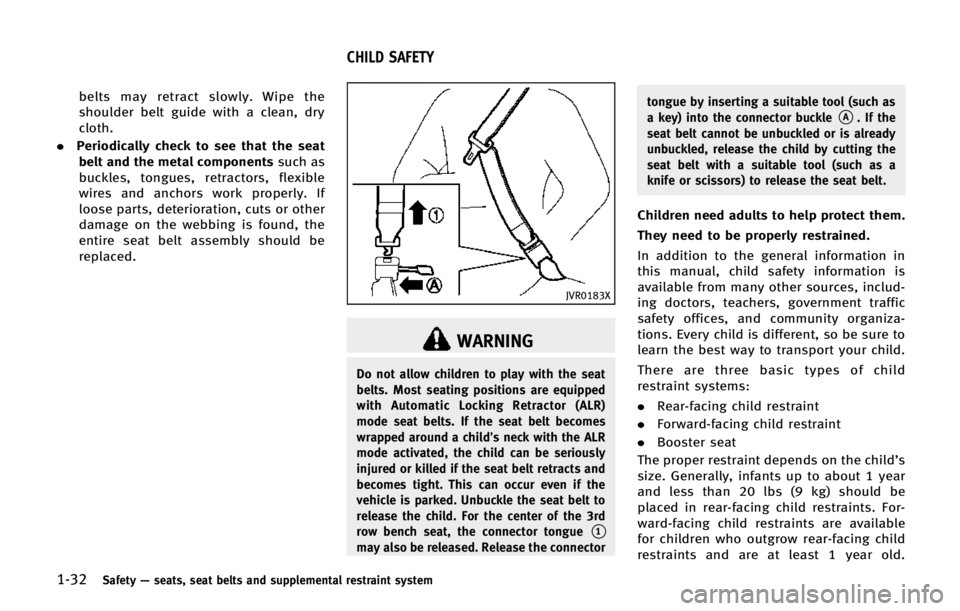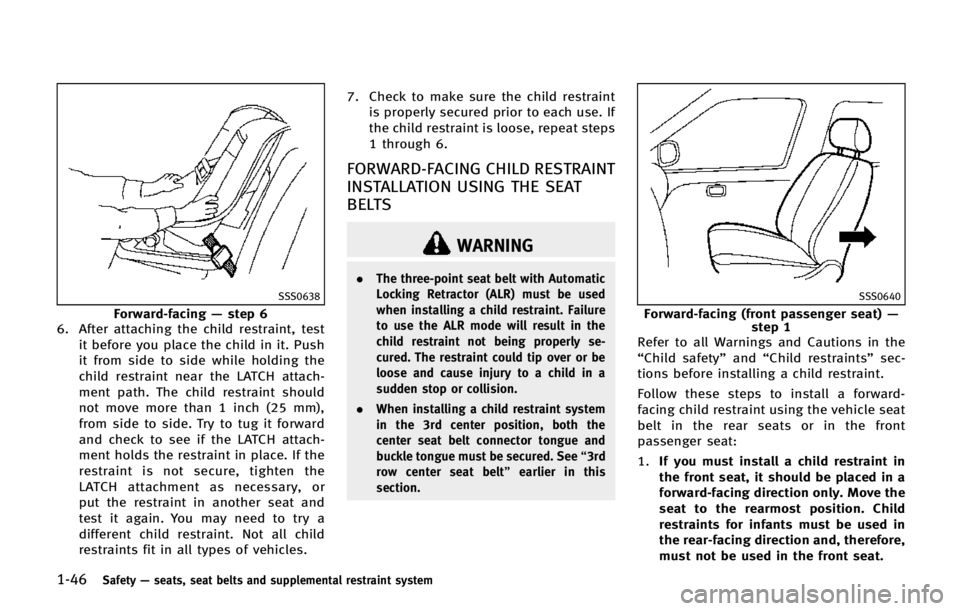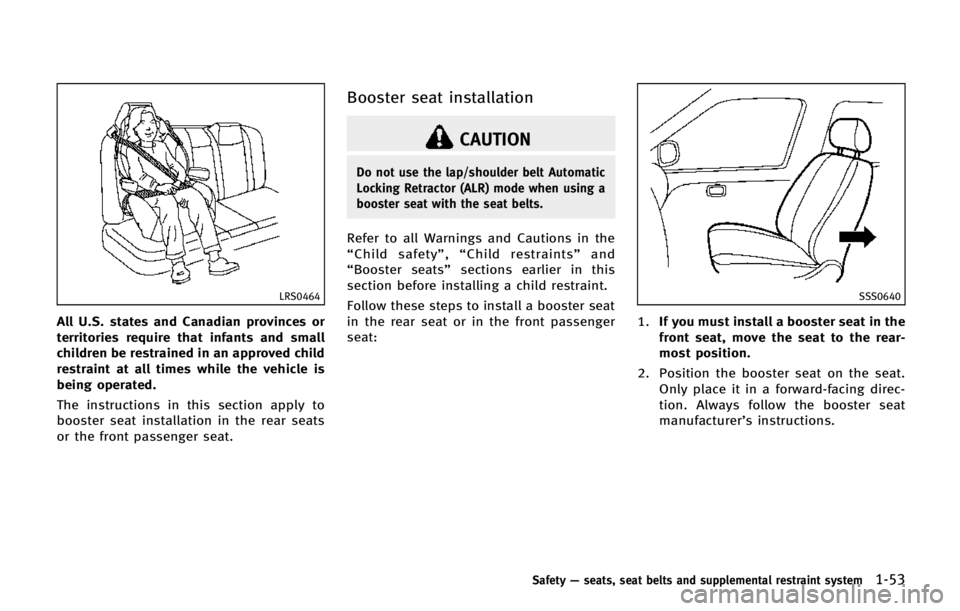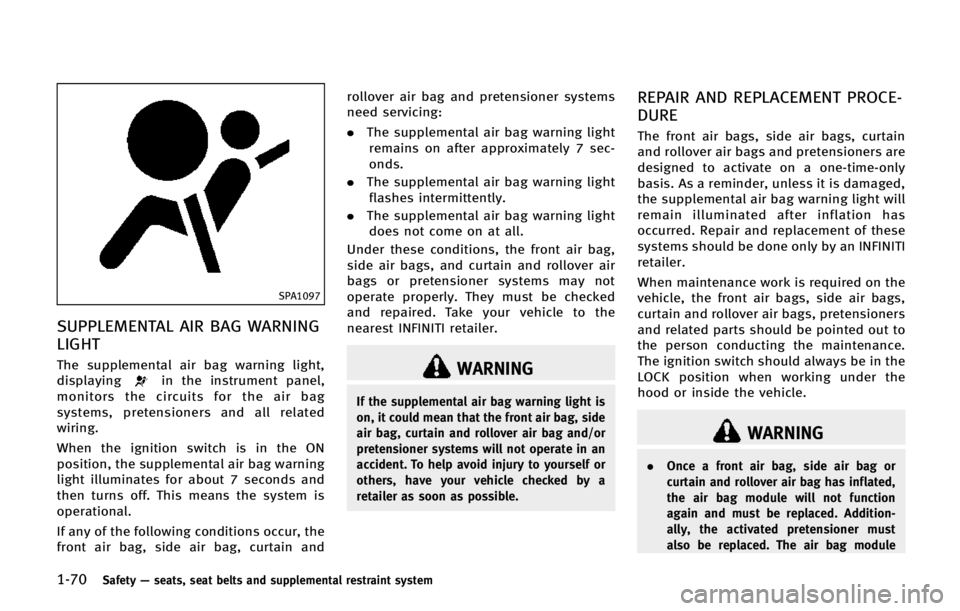lock INFINITI QX80 2014 Owner's Guide
[x] Cancel search | Manufacturer: INFINITI, Model Year: 2014, Model line: QX80, Model: INFINITI QX80 2014Pages: 578, PDF Size: 2.8 MB
Page 53 of 578

1-32Safety—seats, seat belts and supplemental restraint system
belts may retract slowly. Wipe the
shoulder belt guide with a clean, dry
cloth.
. Periodically check to see that the seat
belt and the metal components such as
buckles, tongues, retractors, flexible
wires and anchors work properly. If
loose parts, deterioration, cuts or other
damage on the webbing is found, the
entire seat belt assembly should be
replaced.
JVR0183X
WARNING
Do not allow children to play with the seat
belts. Most seating positions are equipped
with Automatic Locking Retractor (ALR)
mode seat belts. If the seat belt becomes
wrapped around a child’s neck with the ALR
mode activated, the child can be seriously
injured or killed if the seat belt retracts and
becomes tight. This can occur even if the
vehicle is parked. Unbuckle the seat belt to
release the child. For the center of the 3rd
row bench seat, the connector tongue
*1
may also be released. Release the connector tongue by inserting a suitable tool (such as
a key) into the connector buckle
*A. If the
seat belt cannot be unbuckled or is already
unbuckled, release the child by cutting the
seat belt with a suitable tool (such as a
knife or scissors) to release the seat belt.
Children need adults to help protect them.
They need to be properly restrained.
In addition to the general information in
this manual, child safety information is
available from many other sources, includ-
ing doctors, teachers, government traffic
safety offices, and community organiza-
tions. Every child is different, so be sure to
learn the best way to transport your child.
There are three basic types of child
restraint systems:
. Rear-facing child restraint
. Forward-facing child restraint
. Booster seat
The proper restraint depends on the child’s
size. Generally, infants up to about 1 year
and less than 20 lbs (9 kg) should be
placed in rear-facing child restraints. For-
ward-facing child restraints are available
for children who outgrow rear-facing child
restraints and are at least 1 year old.
CHILD SAFETY
Page 62 of 578

SSS0650
Rear-facing—step 4
4. After attaching the child restraint, test
it before you place the child in it. Push
it from side to side while holding the
child restraint near the LATCH attach-
ment path. The child restraint should
not move more than 1 inch (25 mm),
from side to side. Try to tug it forward
and check to see if the LATCH attach-
ment holds the restraint in place. If the
restraint is not secure, tighten the
LATCH attachment as necessary, or
put the restraint in another seat and
test it again. You may need to try a
different child restraint or try installing
by using the vehicle seat belt (if applicable). Not all child restraints fit
in all types of vehicles.
5. Check to make sure the child restraint is properly secured prior to each use. If
the child restraint is loose, repeat steps
1 through 4.
SSS0100
REAR-FACING CHILD RESTRAINT IN-
STALLATION USING THE SEAT BELTS
WARNING
. The three-point seat belt with Automatic
Locking Retractor (ALR) must be used
when installing a child restraint. Failure
to use the ALR mode will result in the
child restraint not being properly se-
cured. The restraint could tip over or be
loose and cause injury to a child in a
sudden stop or collision.
Safety —seats, seat belts and supplemental restraint system1-41
Page 64 of 578

SSS0655
Rear-facing—step 3
3. Pull the shoulder belt until the belt is
fully extended. At this time, the seat
belt retractor is in the Automatic Lock-
ing Retractor (ALR) mode (child restraint
mode). It reverts to the Emergency
Locking Retractor (ELR) mode when
the seat belt is fully retracted.
SSS0656
Rear-facing —step 4
4. Allow the seat belt to retract. Pull up on
the shoulder belt to remove any slack
in the belt.
SSS0657
Rear-facing —step 5
5. Remove any additional slack from the
seat belt; press downward and rear-
ward firmly in the center of the child
restraint to compress the vehicle seat
cushion and seatback while pulling up
on the seat belt.
Safety —seats, seat belts and supplemental restraint system1-43
Page 65 of 578

1-44Safety—seats, seat belts and supplemental restraint system
SSS0658
Rear-facing —step 6
6. After attaching the child restraint, test
it before you place the child in it. Push
it from side to side while holding the
child restraint near the seat belt path.
The child restraint should not move
more than 1 inch (25 mm), from side to
side. Try to tug it forward and check to
see if the belt holds the restraint in
place. If the restraint is not secure,
tighten the seat belt as necessary, or
put the restraint in another seat and
test it again. You may need to try a
different child restraint. Not all child
restraints fit in all types of vehicles. 7. Check to make sure that the child
restraint is properly secured prior to
each use. If the seat belt is not locked,
repeat steps 1 through 6.
After the child restraint is removed and the
seat belt fully retracted, the ALR mode
(child restraint mode) is canceled.
FORWARD-FACING CHILD RESTRAINT
INSTALLATION USING LATCH
Refer to all Warnings and Cautions in the
“Child safety” and“Child restraints” sec-
tions before installing a child restraint.
Follow these steps to install a forward-
facing child restraint using the LATCH
system:
1. Position the child restraint on the seat. Always follow the child restraint man-
ufacturer’s instructions.
SSS0645
Forward-facing web-mounted —step 2
2. Secure the child restraint anchor at-
tachments to the LATCH lower anchors.
Check to make sure the LATCH attach-
ment is properly attached to the lower
anchors.
If the child restraint is equipped with a
top tether strap, route the top tether
strap and secure the tether strap to the
tether anchor point. See “Installing top
tether strap (2nd row captain’s seats or
2nd row bench seat)” later in this
section. Do not install child restraints
that require the use of a top tether
strap in seating positions that do not
have a top tether anchor.
Page 67 of 578

1-46Safety—seats, seat belts and supplemental restraint system
SSS0638
Forward-facing —step 6
6. After attaching the child restraint, test
it before you place the child in it. Push
it from side to side while holding the
child restraint near the LATCH attach-
ment path. The child restraint should
not move more than 1 inch (25 mm),
from side to side. Try to tug it forward
and check to see if the LATCH attach-
ment holds the restraint in place. If the
restraint is not secure, tighten the
LATCH attachment as necessary, or
put the restraint in another seat and
test it again. You may need to try a
different child restraint. Not all child
restraints fit in all types of vehicles. 7. Check to make sure the child restraint
is properly secured prior to each use. If
the child restraint is loose, repeat steps
1 through 6.
FORWARD-FACING CHILD RESTRAINT
INSTALLATION USING THE SEAT
BELTS
WARNING
. The three-point seat belt with Automatic
Locking Retractor (ALR) must be used
when installing a child restraint. Failure
to use the ALR mode will result in the
child restraint not being properly se-
cured. The restraint could tip over or be
loose and cause injury to a child in a
sudden stop or collision.
. When installing a child restraint system
in the 3rd center position, both the
center seat belt connector tongue and
buckle tongue must be secured. See “3rd
row center seat belt” earlier in this
section.
SSS0640
Forward-facing (front passenger seat) —
step 1
Refer to all Warnings and Cautions in the
“Child safety” and“Child restraints” sec-
tions before installing a child restraint.
Follow these steps to install a forward-
facing child restraint using the vehicle seat
belt in the rear seats or in the front
passenger seat:
1. If you must install a child restraint in
the front seat, it should be placed in a
forward-facing direction only. Move the
seat to the rearmost position. Child
restraints for infants must be used in
the rear-facing direction and, therefore,
must not be used in the front seat.
Page 69 of 578

1-48Safety—seats, seat belts and supplemental restraint system
SSS0651
Forward-facing —step 4
4. Pull the shoulder belt until the belt is
fully extended. At this time, the seat
belt retractor is in the Automatic Lock-
ing Retractor (ALR) mode (child restraint
mode). It reverts to Emergency Locking
Retractor (ELR) mode when the seat belt
is fully retracted.
SSS0652
Forward-facing —step 5
5. Allow the seat belt to retract. Pull up on
the shoulder belt to remove any slack
in the belt.
SSS0653
Forward-facing —step 6
6. Remove any additional slack from the
seat belt; press downward and rear-
ward firmly in the center of the child
restraint with your knee to compress
the vehicle seat cushion and seatback
while pulling up on the seat belt.
7. Tighten the tether strap according to the manufacturer’s instructions to re-
move any slack.
Page 70 of 578

SSS0641
Forward-facing—step 8
8. After attaching the child restraint, test
it before you place the child in it. Push
it from side to side while holding the
child restraint near the seat belt path.
The child restraint should not move
more than 1 inch (25 mm), from side to
side. Try to tug it forward and check to
see if the belt holds the restraint in
place. If the restraint is not secure,
tighten the seat belt as necessary, or
put the restraint in another seat and
test it again. You may need to try a
different child restraint. Not all child
restraints fit in all types of vehicles. 9. Check to make sure the child restraint
is properly secured prior to each use. If
the seat belt is not locked, repeat steps
2 through 8.
SSS1099
Forward-facing —step 10
10. If the child restraint is installed in the
front passenger seat, place the ignition
switch in the ON position. The front
passenger air bag status light
should illuminate. If this light is not
illuminated, see “Front passenger air
bag and status light” later in this
section. Move the child restraint to
another seating position. Have the
system checked by an INFINITI retailer.
After the child restraint is removed and the
seat belt is fully retracted, the ALR mode
(child restraint mode) is canceled.
Safety —seats, seat belts and supplemental restraint system1-49
Page 74 of 578

LRS0464
All U.S. states and Canadian provinces or
territories require that infants and small
children be restrained in an approved child
restraint at all times while the vehicle is
being operated.
The instructions in this section apply to
booster seat installation in the rear seats
or the front passenger seat.
Booster seat installation
CAUTION
Do not use the lap/shoulder belt Automatic
Locking Retractor (ALR) mode when using a
booster seat with the seat belts.
Refer to all Warnings and Cautions in the
“Child safety” ,“Child restraints” and
“Booster seats” sections earlier in this
section before installing a child restraint.
Follow these steps to install a booster seat
in the rear seat or in the front passenger
seat:
SSS0640
1. If you must install a booster seat in the
front seat, move the seat to the rear-
most position.
2. Position the booster seat on the seat. Only place it in a forward-facing direc-
tion. Always follow the booster seat
manufacturer’s instructions.
Safety —seats, seat belts and supplemental restraint system1-53
Page 91 of 578

1-70Safety—seats, seat belts and supplemental restraint system
SPA1097
SUPPLEMENTAL AIR BAG WARNING
LIGHT
The supplemental air bag warning light,
displayingin the instrument panel,
monitors the circuits for the air bag
systems, pretensioners and all related
wiring.
When the ignition switch is in the ON
position, the supplemental air bag warning
light illuminates for about 7 seconds and
then turns off. This means the system is
operational.
If any of the following conditions occur, the
front air bag, side air bag, curtain and rollover air bag and pretensioner systems
need servicing:
.
The supplemental air bag warning light
remains on after approximately 7 sec-
onds.
. The supplemental air bag warning light
flashes intermittently.
. The supplemental air bag warning light
does not come on at all.
Under these conditions, the front air bag,
side air bags, and curtain and rollover air
bags or pretensioner systems may not
operate properly. They must be checked
and repaired. Take your vehicle to the
nearest INFINITI retailer.WARNING
If the supplemental air bag warning light is
on, it could mean that the front air bag, side
air bag, curtain and rollover air bag and/or
pretensioner systems will not operate in an
accident. To help avoid injury to yourself or
others, have your vehicle checked by a
retailer as soon as possible.
REPAIR AND REPLACEMENT PROCE-
DURE
The front air bags, side air bags, curtain
and rollover air bags and pretensioners are
designed to activate on a one-time-only
basis. As a reminder, unless it is damaged,
the supplemental air bag warning light will
remain illuminated after inflation has
occurred. Repair and replacement of these
systems should be done only by an INFINITI
retailer.
When maintenance work is required on the
vehicle, the front air bags, side air bags,
curtain and rollover air bags, pretensioners
and related parts should be pointed out to
the person conducting the maintenance.
The ignition switch should always be in the
LOCK position when working under the
hood or inside the vehicle.
WARNING
. Once a front air bag, side air bag or
curtain and rollover air bag has inflated,
the air bag module will not function
again and must be replaced. Addition-
ally, the activated pretensioner must
also be replaced. The air bag module
Page 95 of 578

Intelligent Brake Assist (IBA) OFF switch (if
so equipped) ..................................................... 2-50
Vehicle Dynamic Control (VDC) OFF switch ......... 2-50
Clock ................................................................. 2-51
Adjusting the time ......................................... 2-51
Power outlet ...................................................... 2-52
Storage ............................................................. 2-54 Cup holders .................................................. 2-54
Sunglasses holder ......................................... 2-56
Glove box...................................................... 2-57
Console box .................................................. 2-57
Tray............................................................... 2-58
Coat hooks .................................................... 2-59
Luggage hooks .............................................. 2-59
Cargo floor box ............................................. 2-60
Roof rack....................................................... 2-60
Windows ........................................................... 2-61 Power windows ............................................. 2-61
Moonroof........................................................... 2-63 Automatic moonroof ...................................... 2-64 Welcome light ................................................... 2-65
Battery saver system .................................. 2-65
Interior lights .................................................... 2-66 Map lights ................................................... 2-66
Rear personal lights..................................... 2-66
Interior light control switch .......................... 2-66
Vanity mirror lights ........................................... 2-67
Cargo light ........................................................ 2-68
HomeLink
®Universal Transceiver ...................... 2-68
Programming HomeLink®............................. 2-69
Programming HomeLink®for Canadian
customers and gate openers........................ 2-70
Operating the HomeLink
®
Universal Transceiver ................................... 2-71
Programming troubleshooting ...................... 2-71
Clearing the programmed information .......... 2-71
Reprogramming a single
HomeLink
®button ....................................... 2-71
If your vehicle is stolen ............................... 2-72